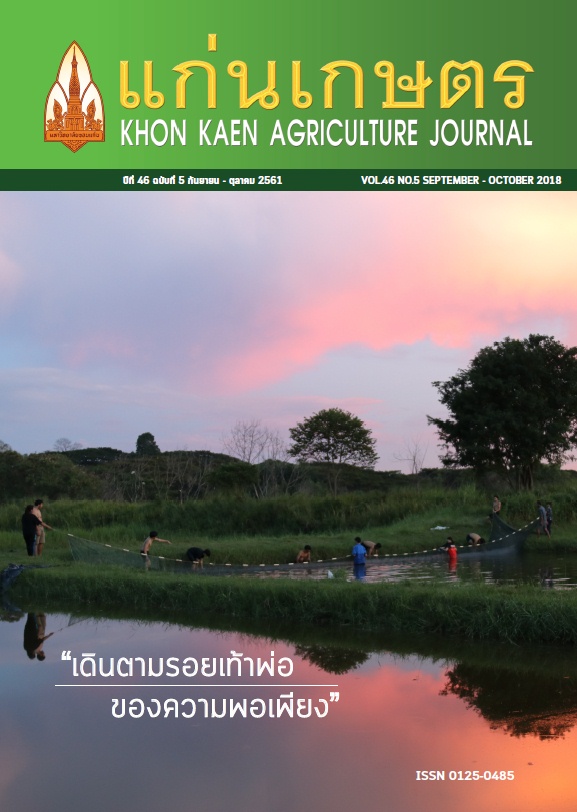Evaluation of Rc and development of Rd markers of white pericarp RD49 and red pericarp Red Hawm Thai rice varieties
Main Article Content
บทคัดย่อ
Red pericarp color in rice is increasing in popularity due to its antioxidant source which promotes several health benefits. The functional Rc gene located in chromosome 7, is a domestication-related gene which is reported to control the red color in the pericarp. However, Rc together with Rd gene is also reported to involve in increasing the red color in the pericarp. The study aimed to find and evaluate DNA marker for Rc gene from published journals, develop marker for Rd gene and validate Rc and Rd markers using the segregating BC1F2 population of RD49 (white pericarp) and Red Hawm (red pericarp). Results showed that the reported Indel-Rc-F/Indel-Rc-R and the designed Rd-F3/Rd-R3 for Rc and Rd gene, respectively, can distinguished between donor parent Red Hawm and recurrent parent RD49. Moreover, Indel-Rc and Rd-F3/Rd-R3 markers accurately anneal to Rc and Rd gene, respectively. Results in validation showed that Indel-Rc-F/Indel-Rc-R primer in BC1F2 plant population and BC1F3 seed families followed the 1:2:1 genotypic ratio and 3:1 phenotypic ratio respectively, for single dominant gene. Indel-Rc marker showed cosegregation in the phenotype of the BC1F3 seed families which have red and white pericarp. The designed Rd-F3/Rd-R3 marker for Rd gene failed to cosegregate with the phenotype resulting in both red and white pericarp in each RdHRdH, RdHRdD and RdDRdD genotypes. Based from these results, only Rc/rc gene is involved in red and white pericarp coloration in Red Hawm and RD49 population. The efficiency and accuracy of Indel-Rc marker can be used in molecular-assisted backcrossing to improve RD49 white to red pericarp in the future.
Article Details
เอกสารอ้างอิง
Brooks S.A., W. Yan, A.K. Jackson, and C.W. Deren. 2008. A natural mutation in rc reverts white-rice-pericarp to red and results in a new, dominant, wild-type allele: Rc-g. Theoretical and Applied Genetics. 117: 575-580.
Chen, P., S.C. Chu, H.L. Chiou, C.L.Chiang, S.F. Yang, and Y.S. Hsieh. 2005. Cyanidin 3-glucoside and peonidin 3-glucoside inhibit tumor cell growth and induce apoptosis in vitro and suppress tumor growth in vivo. Nutrition and Cancer. 53: 232-243
Furukawa, T., M. Maekawa, T. Oki, I. Suda, S. Iilda, H. Shimada, I. Takamure, and K. Kadowaki. 2007. The Rc and Rd genes are involved in proanthocyanidin synthesis in rice pericarp. The Plant Journal. 49: 91-102.
Gross B.L., F.T. Steffen, and K.M. Olsen. 2010. The molecular basis of white pericarps in African domesticated rice: novel mutations at the Rcgene. Journal of Evolutionary Biology. 23: 2747-2753.
Hall, T.A. 1999. BioEdit: a user-friendly biological sequence alignment editor and analysis program for Windows 95/98/NT. Nucleic Acids Symposium Series. 41:95-98.
Itani, T. 2004. History and recent trends of red rice in Japan. Japanese Journal of Crop Science. 73: 137–147
Kijanan, W. 2005. Regulation of genes controlling grain anthocyanin and proanthocyanidin (condensed tannins) accumulation in rice. M. S. Thesis. Kasetsart Univerity, Bangkok.Lau, W., M.Y. Rafii, M.R. Ismail, A. Puteh, M.A. Latif, and A. Ramli. 2015. Review of functional markers for improving cooking, eating, and the nutritional qualities of rice. Frontiers in Plant Science. 6: 832
Lee D., E. Lupotto, and W. Powell. 2009. G-string slippage turns white rice red. Genome. 52: 490-493.
Lim, S.H., and S.H. Ha. 2013. Marker development for the identification of rice seed color. Plant Biotechnology Reports. 7: 391.
Ling, W.H., Q.X. Cheng, J. Ma, and T. Wang. 2001. Red and black rice decrease atherosclerotic plaque formation and increase antioxidant status in rabbits. The Journal of Nutrition. 131: 1421-1426Oki, T., M. Masuda, M. Kobayashi, Y. Nisiba, S. Furuta, I. Suda, and T. Sato. 2002. Polymeric procyanidins as radical-scavenging components in red-hulled rice. Journal of Agricultural and Food Chemistry. 50: 7524-7529
Nakai, K., Y. Inagaki, H. Nagata, C. Miykzaki, and S. Iida. 1998. Molecular characterization of the gene for dihydroflavonol 4-reductase of Japonica rice varieties. Plant Biotechnology. 15: 221-225.
Nadeem, M.A., M.A. Nawz, M.Q. Shahid, Y. Dogan, G. Comertpay, M. Yildiz, R. Hatipoglu, F. Ahmad, and N. Labhane. 2018. DNA molecular markers in plant breeding: current status and recent advancements in genomic selection and genome editing. Biotechnology & Biotechnological Equipment. 32: 261-285.
Rysbekova, A., D. Kazkeyev, B. Usenbekov, Z.M. Mukhina, E. Zhanbyrbaev, I.A. Sartbaeva, K.Zh. Zhambakin, KH.A. Berkimbay, and D.S. Batayeva. 2017. Prebreeding selection of rice with colored pericarp based on genotyping Rcand Pb genes. Russian Journal of Genetics. 53: 49-58.
Sahu G., A. Sarawgi, B. Sharma, and M. Parikh. 2010. Inheritance of Anthocyanin Pigmentation in Rice. Journal of Rice Research. 3: 19-23.
Sweeney, M.T., M. L. Thomson, B.E. Pfeil, and S. McCouch. 2006. Caught red-handed: Rcencodes a basic helix-loop-helix protein conditioning red pericarp in rice. Plant Cell. 18:283-194.
Suzuki, M., T. Kimura, K. Yamagishi, H. Shinmoto, and K. Yamaki. 2004. Comparison of mineral contents in 8 cultivars of pigmented brown rice. Journal of the Japanese Society for Food Science and Technology.
Thompson, J.D., T.J. Gibson, F. Plewniak, F. Jeanmougin, and D.G. Higgins. 1997. The CLUSTAL_X windows interface: flexible strategies for mutiple sequence alignment aided by quality analysis tools. Nucleic Acids Research. 25: 4876-4882.
Untergasser, A., I. Cutcutache, T. Koressaar, J. Ye, B.C. Faircloth, M. Remm, and S.G. Rozen. 2012. Primer3 – new capabilities and interfaces. Nucleic Acids Research. 40: 115.
Yang, J., J. Wang, Q. Cao, Z. Chen, L.H. Tang, and W.G. Zhong. 2009. Genetic analysis of red pericarp in weedy rice (Oryza sativa L. f. spontaneous). Acta Botanica Boreali-Occidentalia Sinica. 29: 1084-1090.
Yawadio, R., S. Tanimori, and M. Morita. 2007. Identification of phenolic compounds isolated from pigmented rices and their aldose reductase inhibitory activities. Food Chemistry. 101: 1616-1625.


